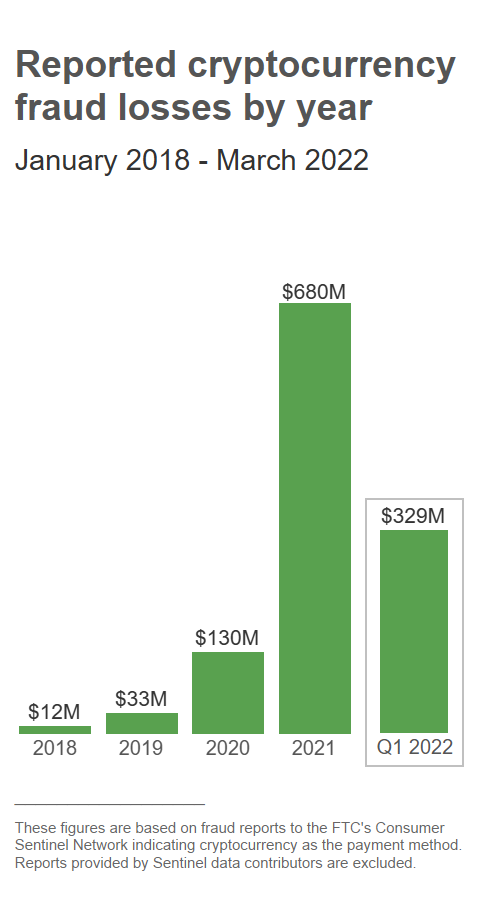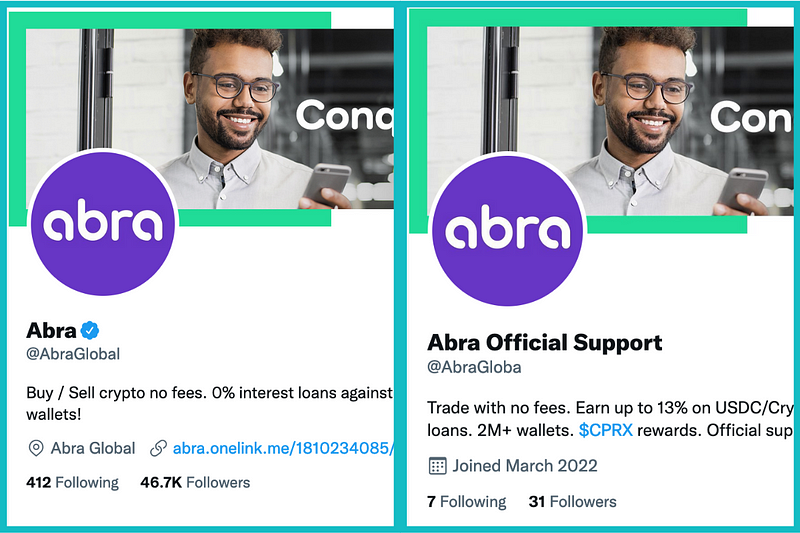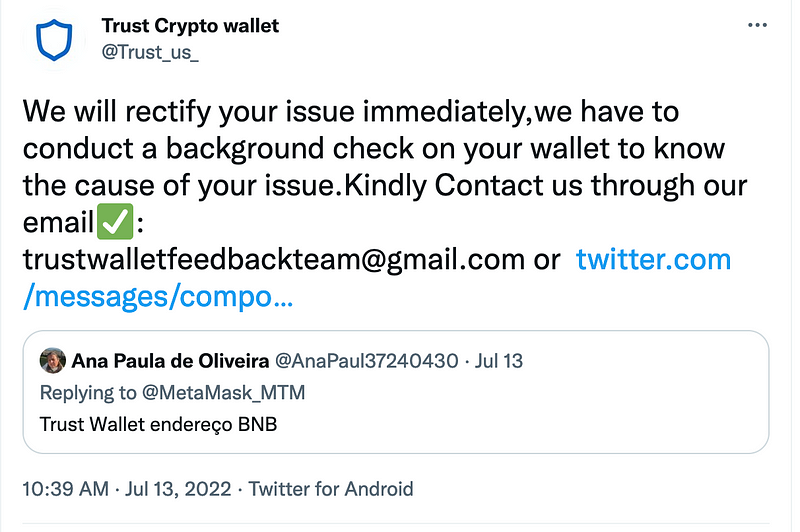How to avoid such scams and protect yourself
Scammers constantly come up with new ways to trick people online and steal their money and financial information. The cryptocurrency market increased from $200 billion in 2017 to $3 trillion in 2021 attracting not only new investors and traders, but also scammers [1].
Cryptocurrencies have become the new weapon for scammers and the scams have cost people more than $1 billion since 2021 according to FTC [3]. In this article, we will explain how cryptocurrency scams work and how to avoid them.
What you need to know about cryptocurrency
According to the Oxford Dictionary, “Cryptocurrency, or crypto, is a digital currency in which transactions are verified and records are maintained by a decentralized system using cryptography, rather than by a centralized authority.”
In other words, cryptocurrency is a digital currency that exists only electronically and relies on encryption algorithms (blockchain) rather than centralized banks to verify transactions.
How crypto works
You can pay using crypto whenever the business accepts it as a payment method. Or, you can invest in the crypto market, hoping the value goes up. Popular cryptocurrency examples: Bitcoin, Litecoin, Ethereum, Zcash…
Crypto vs. physical money
Unlike traditional money, the value of cryptocurrency is volatile and changes fast, for example, hourly. Also, it is not secured by the government. In the case of crypto fraud, the government cannot assist in indemnifying the loss [3].
Why crypto is attractive to scammers
According to the FTC, more than 46,000 people have reported losing over $1 billion in crypto scams since the beginning of 2021, almost sixty times what they lost in 2018 [3].

Reported cryptocurrency fraud losses by year[3]
In the same period, of every ten dollars lost on social media scams, four were lost in crypto. Instagram (32%), Facebook (26%), WhatsApp (9%), and Telegram (7%) were the top platforms used in those scams [2].
Scammers prefer crypto to fool their victims for different reasons:
-
- First, cryptocurrency payments are not reversible. Once the transaction is done, you can not get your money back.
-
- Second, there is no legal protection over crypto transactions.
-
- Even though crypto has anonymous criteria, some information is recorded on the blockchain, like the transaction amount, and wallet addresses of the sender and recipient.
-
- People are still confused and unfamiliar with how cryptocurrencies work and scammers take advantage of that.
Types of crypto scams
Scammers can lure you to invest in cryptocurrencies with zero risk by adopting one of the following methods:
Fake crypto websites and apps
Fraudsters create investment crypto apps and websites available for download through Google Play and the Apple App Store that promise massive returns on investment. Initially, you see good results and they deceive you to invest more. Once you request to withdraw your money, the application will refuse the request or shut down.
Phishing scams
In a phishing scam, the scammer steals online wallets’ private keys by sending emails, DMs, and posts on social media, or directing their victims to bogus websites to enter that information.
Pump and dump schemes
In these schemes, fraudsters buy coins at a low price. Then they start spreading fake information, which is in favor of the coin’s value, to overhype the coin over social media platforms such as Twitter, Facebook, LinkedIn, or Telegram. As more traders are buying the asset, the coin value continues to rise. Then fraudsters sell their stakes suddenly.
Since they possess a significant percentage of the shares, it causes a crash in the coin market, causing everyone else a significant financial loss.
Fake celebrity endorsements
To attract potential victims’ attention, cryptocurrency fraudsters claim endorsements from celebrities, businesses, or influencers to sell fake cryptocurrency to amateur investors. These frauds are using well-designed fabricated pictures and websites to demonstrate celebrity backing from big names like Bill Gates, Elon Musk, and others.
Impersonation scams
By impersonating a well-known company, business, or influencer, scammers succeed in convincing you to send them cryptocurrencies.
They can pretend they are from Amazon, Microsoft, or other companies and contact you via social media or email to warn you of a risk you need to fix. In return, they will ask you to send them crypto in advance, which is a scam. Or, they may create their own fake crypto and back it up with a professional website and social media accounts to trick you into investing in this new coin.
One of the very common scams is that the scammer impersonates the CEO or CTO of the crypto company and then starts sending messages to the followers of the real account (figure 1).

Figure 1: VIP impersonation using a fake profile (right) of ARKInvest’s CEO on Twitter
Or they impersonate the official account of the crypto company and start sending DMs to the official account’s followers (figures 2 and 3).

Figure 2: Fake customer support profile (right) of Abra Global on Twitter

Figure 3: Profile impersonating Trust Crypto Wallet on Twitter
The fake account has a similar handle name and bio as the real one except for minor differences such as the missing dash in the name and the word “safely” changed to “safety”. The scammers often make such changes to fool traditional methods of catching impersonation and to bypass getting caught by the platform’s automated programs. This may explain why the fake account, which has 1000+ followers, has existed for so many years without getting taken down.
Below is a tweet from the impersonation account of Trust Crypto, trying to scam users with fake customer support (figure 4):

Figure 4: Tweet from fake customer support scamming customers of Trust Crypto Wallet
Another way for scammers to steal your money is to list fake jobs, for example, jobs on recruiting investors or converting cash to crypto. Most of the time, those jobs ask for a fee in cryptocurrency.
Red flags of crypto fraud
We can spot a cryptocurrency scam by paying attention to the following warning signs:
-
- Guaranteed profit: investment is an uncertain business; the profit can increase or decrease fast. Therefore, never trust a crypto post, ad, or offer promising sure returns.
-
- Payment in advance: Fake businesses and scammers demand that you send fees in cryptocurrency in advance.
-
- Heavy marketing: Fraudsters focus on reaching out to a massive audience through social media and influencers to advertise their cryptocurrency fast.
-
- Anonymous team: In most crypto scams, there is no online presence of the business team members. In cases where the scammer does have an online profile on social media, it will be an impersonation profile of one of the members of the real company.
How to protect yourself from cryptocurrency scams
You can avoid being a crypto scam victim by following those steps:
-
- Protect your crypto account and wallet online by keeping your wallet keys private. Do not share them with anyone.
-
- Learn more before investing in crypto. Do your research on the investment opportunity and the team of people behind it.
-
- Be cautious of social media crypto advertising as it is the number one tool for scammers to lure victims to their fake crypto.
-
- Download apps from the official websites.
-
- Do not trust shiny offers that guarantee profits on crypto investments.
In case you fall victim to such a scam, don’t hesitate to contact your bank and report the fraud to the FTC or any other official department in your country.
Brand protection from impersonation scams
Companies need to secure their online image and protect their users from online scams. The Eydle platform protects businesses online from impersonation attacks using AI technologies. To understand how the Eydle platform can identify and take down impersonation accounts on social media, contact us at [email protected] or visit www.eydle.com.
References
[1]https://coinmarketcap.com/charts/
[2] https://www.kaspersky.com/resource-center/definitions/what-is-cryptocurrency
[5] https://consumer.ftc.gov/articles/what-know-about-cryptocurrency-and-scams
[6] https://www.kaspersky.com/resource-center/definitions/cryptocurrency-scams




